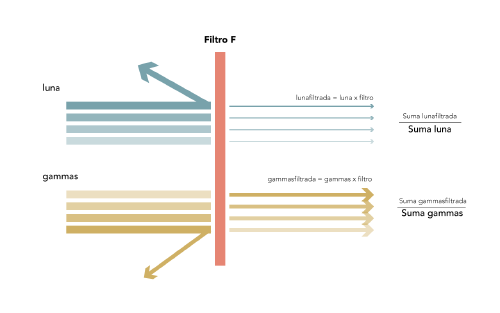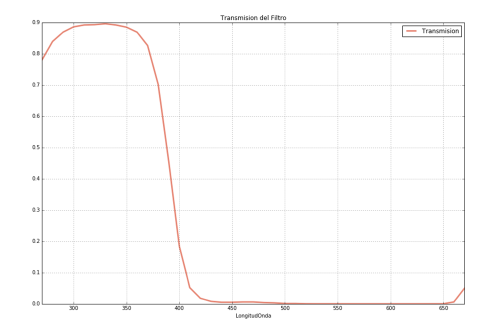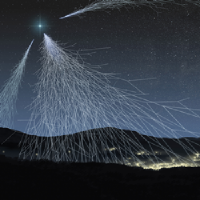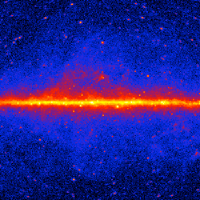
Night 1:Pointing with the telescopes
How can you reduce the mount of moonlight?
How can you reduce the mount of moonlight?
You can buy filters for any normal camera in many stores. But those needed for the MAGIC telescopes can’t even be found on the internet because they aren’t in the market. So, we have no choice but to go to the workshop and design them ourselves.
Once we have them, we have to test them to see if they really do work. How do we know if they stop the moonlight from getting trhough, but let through the gamma rays that we’re on the hunt for? Remember that, we only want to take out the moonlight from the pictures we take.

The filter partially gets rid of the moonlight and lets some of the gamma rays pass through. But it's not perfect! With this scheme, it is possible to figure out if the filter works as expected.
In the notebook on the right you’ll see how we do the calculation. We could do it just as well with pencil and paper but, that’s a cop out, right? With a couple of lines of code, it’s much easier to solve. Feel free to have a good play around with the notebook - you can’t break anything, don’t worry.
Hunters use codes to work with telescope data. Don't be put off by the coding; computers only do what we tell them. And if you get good at doing this, they help you do things more quickly.
The filter absorbs various amount of light depending on the wavelength. The light coming from the moon and the gammas have different intensities, which also depend on the wavelength. So, we have to look at how much light from the gammas passes through and how much of the moonlight is absorbed for each wavelength. To find out the total, we simply add all the values together.
To know how much light we have after the filter, we need to multiply the intensity by F (the fraction of light that passes through the filter). If the filter was perfect, we would multiply the type of light we’re interested in by 1, and the one we want to eliminate by 0. But we don’t live in a perfect world. At times, we have no choice but to adapt somewhat.

The graphs seem very abstract, but in reality they can tell us many things. Look at what is shown on each axis and try to relate it to the filter. Which light goes through? Which light is absorbed?
Did you notice that to compare the light that reaches the filter and the light that actually goes though it (or is absorbed), we divide the two intensity values? If you think about it, you’ll see that it’s the best way: if the result is close to 1, it means that the two values are similar. If not, then they’re very different.
We have to insist, though, that the filters aren’t perfect, but they do work pretty well. The goal was to avoid the moonlight causing problems, and it seems that they work quite well! With these filters, we can investigate for longer but without being put off by the light that our satellite reflects. The only thing left to do is install the filters, so that we can use them during the observations.
Daniel’s scientific notebook
This is my scientific notebook. Here I can see the data I got from using the telescopes, doing calculations and making annotations. It’s one more tool that the gamma-ray hunters have. All the hunters have our own and you’ll find yours in Your Night.
It’s probably easier to learn how it works with an example. So let’s work out if the filters we have designed are the right ones or not.
We have 3 data sets.
- One has the data for the amount of moonlight that reaches the telescopes.
- Another has the data for the light from the gamma rays that reaches the telescopes.
- The last one has the information of how much light (from the moon or from the gammas) passes through the filter.
Each file shows us the information according to wavelength.
WARTH OUT! Remember that to execute the code that is in each of the command cells you must press SHIFT + ENTER. And if for any reason you double click on a text cell like this one, you will see the text without any formatting. Pressing SHIFT + ENTER will let you see it again.
Let’s go through the data set that tells us the amount of light from the moon that reaches the telescopes:
%matplotlib inline
from noche1_2 import *
leer("luna")
LongitudOnda Emision
------------ ---------
270 0.0921
280 0.077652
290 0.0042408
300 0.049055
310 0.034728
320 0.33099
330 0.4941
340 0.58336
350 0.59861
360 0.79136
... ...
570 5.6372
580 6.0073
590 5.8452
600 6.3041
610 6.4821
620 6.7191
630 6.6753
640 6.9272
650 7.3382
660 7.8201
670 8.2151
Length = 41 rows
But what does each column mean?
- Well, the first column is the wavelength measured in nanometres.
- The second is the intensity of the emission of the moon. The units of the intensity are arbitrary (a.u).
Look at the data and see what format they’re in. But if you really want to get more information from them, it’s much better to represent them graphically.
Look carefully at the axes of the graph. On the X-axis, there’s the wavelength, and on the Y-axis there’s the emissions from the moon. Pay careful attention to the scale of the Y-axis.
grafica("luna")

With this graph, it’s easy to see that the amount of moonlight increases for longer wavelengths (interesting side note: you do know that itn’t really moonlight since the moon only reflects light, right?).
Let’s look at what happens with the gamma-ray light and the filters:
grafica("luna")
grafica("gammas")
grafica("filtro")

Now we can compare how much light comes to us from the moon and how much we get from the gammas.
- Which is more intense? The moon or the gammas?
- Do you know what part of the light gets through the filter and what part is absorbed?
The light that comes from the gamma rays increases very fast with a wavelength of between 250 and 350 nanometres, but then, unlike the one coming from the moon, it decreases for longer wavelengths. Hence, we chose a filter that had a good transmission below 350 nanometres and that wouldn’t let light over 400 nanometres pass.
Now, it’s time to calculate how much light from the moon and gammas goes through the filter. The goal is for the filter to eliminate the moon but not the gammas. But there’s no such thing as a perfect filter.
The calculation is simple: we must multiply the intensity of the moon by the filter for each wavelength.
multiplicar("luna","filtro")
totalluna: 144.48
lunafiltrada:
[ 7.18380000e-02 6.51500280e-02 3.68525520e-03 4.34627300e-02
3.09773760e-02 2.95574070e-01 4.42713600e-01 5.20357120e-01
5.29769850e-01 6.87691840e-01 8.37316200e-01 7.43137200e-01
5.62607500e-01 3.47318400e-01 9.97204000e-02 3.71880000e-02
1.34568000e-02 1.41795000e-02 1.69920000e-02 2.11032000e-02
2.16384000e-02 1.72076000e-02 1.34841000e-02 4.39160000e-03
4.62880000e-03 9.34700000e-04 4.04688000e-04 3.00882000e-04
3.74871000e-04 2.12456000e-04 0.00000000e+00 0.00000000e+00
0.00000000e+00 0.00000000e+00 0.00000000e+00 0.00000000e+00
6.67530000e-05 4.15632000e-04 7.33820000e-04 4.69206000e-02
4.10755000e-01]
totallunaFiltrada: 5.91
And the same goes for the light from the gamma rays:
multiplicar("gammas", "filtro")
totalgammas: 22.36
gammasfiltrada
[ 8.22120000e-02 7.50905000e-02 3.28568900e-01 6.22946600e-01
7.08158800e-01 7.37975200e-01 7.53177600e-01 7.47942000e-01
7.26408000e-01 7.03021000e-01 6.51714000e-01 5.42575800e-01
3.39794000e-01 1.34264800e-01 3.71436000e-02 1.24290000e-02
5.43600000e-03 3.25500000e-03 3.19050000e-03 3.70620000e-03
3.51840000e-03 2.27640000e-03 1.64160000e-03 5.24400000e-04
5.19700000e-04 1.01160000e-04 3.89920000e-05 2.83140000e-05
3.16680000e-05 1.75800000e-05 0.00000000e+00 0.00000000e+00
0.00000000e+00 0.00000000e+00 0.00000000e+00 0.00000000e+00
3.51200000e-06 2.05260000e-05 3.33900000e-05 1.91700000e-03
1.50750000e-02]
totalgammasFiltrada: 7.24
As you can see, for the moon we went from totalluna = 144 to totallunafiltrada = 6, that is to say that we’re left with 4% of the moonlight.
But for the gammas, we went from totalgammas = 22 to totalgammasFiltrada = 7, which is a much smaller reduction.
Let’s check those numbers:
totallunaFiltrada/totalluna
0.040883189190507568
totalcherenkovFiltrada/totalcherenkov
0.32407190844270289
What do you think? Do the filters work? Proportionally, do they allow more moonlight or more light from the gammas to pass through?
The filters are not perfect, but they work quite well. So, now, we can observe gamma rays, even when it’s a full moon. This means we have much more time to keep looking for gammas. And that, as you’ll soon see, is very important.
This is your first scientific notebook, your first step as a gamma-ray hunter. Keep on going into the night; Many high-energy surprises await you!

Dictionary of the gamma ray hunter
Active Galactic Nuclei
There's party going on inside!
This type of galaxy (known as AGN) has a compact central core that generates much more radiation than usual. It is believed that this emission is due to the accretion of matter in a supermassive black hole located in the centre. They are the most luminous persistent sources known in the Universe.
Find out more:
Black Hole
We love everything unknown. And a black hole keeps many secrets.
A black hole is a supermassive astronomical object that shows huge gravitational effects so that nothing (neither particles nor electromagnetic radiation) can overcome its event horizon. That is, nothing can escape from within.
Blazar
No, it's not a 'blazer', we aren't going shopping
A blazar is a particular type of active galactic nucleus, characterised by the fact that its jet points directly towards the Earth. In other words, it’s a very compact energy source associated with a black hole in the centre of a galaxy that’s pointing at us.
Cherenkov Radiation
It may sound like the name of a ames Bond villain, but this phenomenon is actually our maximum object of study
Cherenkov radiation is the electromagnetic radiation emitted when a charged particle passes through a dielectric medium at a speed greater than the phase velocity of light in that medium. When a very energetic gamma photon or cosmic ray interacts with the Earth’s atmosphere, a high-speed cascade of particles is produced. The Cherenkov radiation of these charged particles is used to determine the origin and intensity of cosmic or gamma rays.
Find out more:
Cherenkov Telescopes
Our favourite toys!
Cherenkov telescopes are high-energy gamma photon detectors located on the Earth’s surface. They have a mirror to gather light and focus it towards the camera. They detect light produced by the Cherenkov effect from blue to ultraviolet on the electromagnetic spectrum. The images taken by the camera allow us to identify if the particular particle in the atmosphere is a gamma ray and at the same time determine its direction and energy. The MAGIC telescopes at Roque de Los Muchachos (La Palma) are an example.
Find out more:
Cosmic Rays
You need to know how to distinguish between rays, particles and sparks!
Cosmic rays are examples of high-energy radiation composed mainly of highly energetic protons and atomic nuclei. They travel almost at the speed of light and when they hit the Earth’s atmosphere, they produce cascades of particles. These particles generate Cherenkov radiation and some can even reach the surface of the Earth. However, when cosmic rays reach the Earth, it is impossible to know their origin, because their trajectory has changed. This is due to the fact that they have travelled through magnetic fields which force them to change their initial direction.
Find out more:
Dark Matter
What can it be?
How can we define something that is unknown? We know of its existence because we detect it indirectly thanks to the gravitational effects it causes in visible matter, but we can’t study it directly. This is because it doesn’t interact with the electromagnetic force so we don’t know what it is composed of. Here, we are talking about something that represents 25% of everything known! So, it’s better not to discount it, but rather try to shed light on what it is …
Find out more:
Duality Particle Wave
But, what is it?
A duality particle wave is a quantum phenomenon in which particles take on the characteristics of a wave, and vice versa, on certain occasions. Things that we would expect to always act like a wave (for example, light) sometimes behave like a particle. This concept was introduced by Louis-Victor de Broglie and has been experimentally demonstrated.
Find out more:
Event
These really are the events of the year
When we talk about events in this field, we refer to each of the detections we make via telescopes. For each of them, we have information such as the position in the sky, the intensity, and so on. This information allows us to classify them. We are interested in having many events so that we can carry out statistical analysis a posteriori and draw conclusions.
Gamma Ray
Yes, we can!
Gamma rays are extreme-frequency electromagnetic ionizing radiation (above 10 exahertz). They are the most energetic range on the electromagnetic spectrum. The direction from which they reach the Earth indicates where they originate from.
Find out more:
Lorentz Covariance
The privileges of certain equations.
Certain physical equations have this property, by which they don’t change shape when certain coordinates changes are given. The special theory of relativity requires that the laws of physics take the same form in any inertial reference system. That is, if we have two observers whose coordinates can be related by a Lorentz transformation, any equation with covariant magnitudes will be written the same in both cases.
Find out more:
Microquasar
Below you will learn what a quasar is...well a microquasar is the same, but smaller!
A microquasar is a binary star system that produces high-energy electromagnetic radiation. Its characteristics are similar to those of quasars, but on a smaller scale. Microquasars produce strong and variable radio emissions often in the form of jets and have an accretion disk surrounding a compact object (e.g. a black hole or neutron star) that’s very bright in the range of X-rays.
Find out more:
Nebula
What shape do the clouds have?
Nebulae are regions of the interstellar medium composed basically of gases and some chemical elements in the form of cosmic dust. Many stars are born within them due to condensation and accumulation of matter. Sometimes, it’s just the remains of extinct stars.
Find out more:
Particle Shower
The Niagara Falls of particles!
A particle shower results from the interaction between high-energy particles and a dense medium, for example, the Earth’s atmosphere. In turn, each of these secondary particles produced creates a cascade of its own, so that they end up producing a large number of low-energy particles.
Pulsar
Now you see me, now you don't
The word ‘pulsar’ comes from the shortening of pulsating star and it is precisely this, a star from which we get a discontinuous signal. More formally speaking, it’s a neutron star that emits electromagnetic radiation while it’s spinning. The emissions are due to the strong magnetic field they have and the pulse is related to the rotation period of the object and the orientation relative to the Earth. One of the best known and studied is the pulsar of the Crab Nebula, which, by the way, is very beautiful.
Find out more:
Quantum Gravity
A union of 'grave' importance ...
This field of physics aims to unite the quantum field theory, which applies the principles of quantum mechanics to classical systems of continuous fields, and general relativity. We want to define a unified mathematical basis with which all the forces of nature can be described, the Unified Field Theory.
Find out more:
Quasar
A 'quasi' star
Quasars are the furthest and most energetic members of a class of objects called active core galaxies. The name, quasar, comes from ‘quasi-stellar’ or ‘almost stars’. This is because, when they were discovered, using optical instruments, it was very difficult to distinguish them from the stars. However, their emission spectrum was clearly unique. They have usually been formed by the collision of galaxies whose central black holes have merged to form a supermassive black hole or a binary system of black holes.
Find out more:
Supernova Remnant
A candy floss in the cosmos
When a star explodes (supernova) a nebula structure is created around it, formed by the material ejected from the explosion along with interstellar material.
Find out more:
Theory of relativity
In this life, everything is relative...or not!
Albert Einstein was the genius who, with his theories of special and general realtivity, took Newtonian mechanics and made it compatible with electromagnetism. The first theory is applicable to the movement of bodies in the absence of gravitational forces and in the second theory, Newtonian gravity is replaced with more complex formulas. However, for weak fields and small velocities it coincides numerically with classical theory.
Find out more:



















